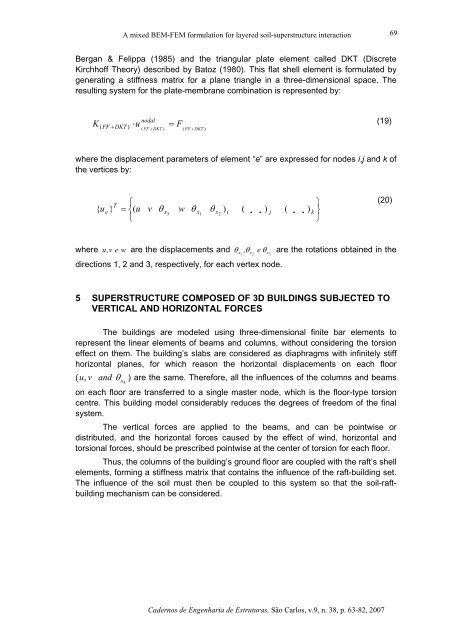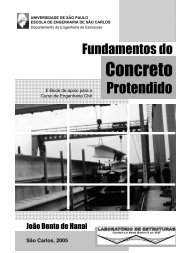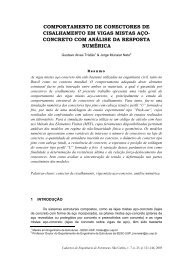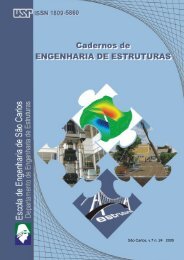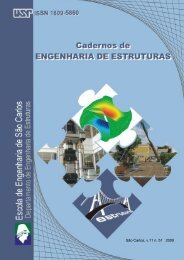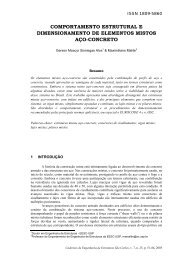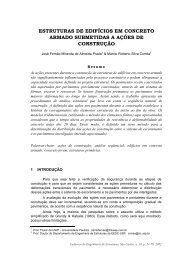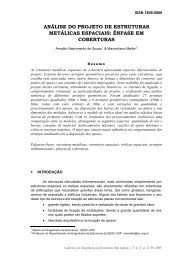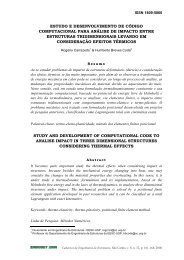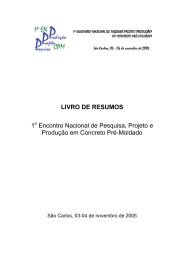download completo - SET - USP
download completo - SET - USP
download completo - SET - USP
Create successful ePaper yourself
Turn your PDF publications into a flip-book with our unique Google optimized e-Paper software.
A mixed BEM-FEM formulation for layered soil-superstructure interaction<br />
69<br />
Bergan & Felippa (1985) and the triangular plate element called DKT (Discrete<br />
Kirchhoff Theory) described by Batoz (1980). This flat shell element is formulated by<br />
generating a stiffness matrix for a plane triangle in a three-dimensional space. The<br />
resulting system for the plate-membrane combination is represented by:<br />
K<br />
nodal<br />
( FF DKT ) ⋅u<br />
= F<br />
( FF + DKT ) ( FF + DKT )<br />
+<br />
(19)<br />
where the displacement parameters of element “e” are expressed for nodes i,j and k of<br />
the vertices by:<br />
T ⎧<br />
{ u e}<br />
= ⎨(<br />
u v θ x w θ x θ x ) i (<br />
⋅ ⋅<br />
) j (<br />
⋅ ⋅ )<br />
3 1 2<br />
⎩<br />
k<br />
⎫<br />
⎬<br />
⎭<br />
(20)<br />
where u, v e w are the displacements and θ , x<br />
θ<br />
1 x<br />
e θ<br />
2 x<br />
are the rotations obtained in the<br />
3<br />
directions 1, 2 and 3, respectively, for each vertex node.<br />
5 SUPERSTRUCTURE COMPOSED OF 3D BUILDINGS SUBJECTED TO<br />
VERTICAL AND HORIZONTAL FORCES<br />
The buildings are modeled using three-dimensional finite bar elements to<br />
represent the linear elements of beams and columns, without considering the torsion<br />
effect on them. The building’s slabs are considered as diaphragms with infinitely stiff<br />
horizontal planes, for which reason the horizontal displacements on each floor<br />
( u, v and θ x 3<br />
) are the same. Therefore, all the influences of the columns and beams<br />
on each floor are transferred to a single master node, which is the floor-type torsion<br />
centre. This building model considerably reduces the degrees of freedom of the final<br />
system.<br />
The vertical forces are applied to the beams, and can be pointwise or<br />
distributed, and the horizontal forces caused by the effect of wind, horizontal and<br />
torsional forces, should be prescribed pointwise at the center of torsion for each floor.<br />
Thus, the columns of the building’s ground floor are coupled with the raft’s shell<br />
elements, forming a stiffness matrix that contains the influence of the raft-building set.<br />
The influence of the soil must then be coupled to this system so that the soil-raftbuilding<br />
mechanism can be considered.<br />
Cadernos de Engenharia de Estruturas, São Carlos, v.9, n. 38, p. 63-82, 2007


